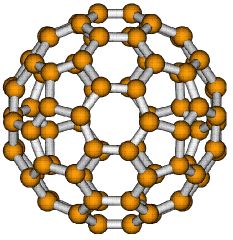

 Skip to navigation
Skip to navigation
Site Primary Navigation:
- About SDSC
- Services
- Support
- Research & Development
- Education & Training
- News & Events
Search The Site:

| TERASCALE HORIZONS | Contents | Next | |
Predicting Molecular Properties with Dalton |
|
| FEATURED Kenneth Ruud, University of Oslo, Norway, and SDSC Dan Jonsson, Linköping University, Sweden, and SDSC Peter R. Taylor, UC San Diego and SDSC |
|
|
DALTON DOES THATBLUE HORIZON RESULTSREFERENCE Jonsson, D., K. Ruud, and P.R. Taylor. 1999. Parallel calculations of molecular properties. Computational Physics Communications |
|
|
|
 |
Figure 1. Optical Properties
C84 is one of the fullerenes whose nonlinear optical properties are under study using Dalton on NPACI's Blue Horizon. |
|
|
|
DALTON DOES THATDalton is a general-purpose quantum chemistry computer program that can perform large-scale molecular property calculations for big molecules. The name honors the English chemist and father of atomic theory, John Dalton (1766-1844). The 26 authors of Dalton Release 1.0 (1997), led by Trygve Helgaker of the University of Oslo, include groups from Norway, Sweden, Denmark, and collaborators including Taylor from several other countries. Helgaker's doctoral student, Kenneth Ruud--a principal author and administrator of Dalton--is a postdoctoral researcher in Taylor's group supported by the Norwegian Research Council. Also in the group is another Dalton developer, Dan Jonsson, who recently obtained his doctorate from the Computational Physics Department of Linköping University in Sweden. Dalton's main Web site is now mirrored at SDSC. "Response theory is at the heart of Dalton," Ruud said, "because it provides a transparent way to treat the time-dependence of applied perturbations, such as a light beam, on a quantum mechanical system. The higher-order properties for which Dalton is optimized include static and frequency-dependent responses as well as properties that depend on internal or external electric and magnetic field perturbations." The interesting physics and chemistry within Dalton's reach include nonlinear optical properties of polymers and electric and magnetic properties of fullerenes (the multicarbon "buckyballs"). Jonsson, Ruud, and Taylor have written an article for Computational Physics Communications detailing Dalton's capabilities. Dalton is one of the first codes to be run on SDSC's teraflops machine, Blue Horizon. The San Diego group is initiating a collaboration with Philip J. Stephens of the University of Southern California to explore nonlinear optical properties of chiral organic polymers. However, the first calculations tried on Blue Horizon concerned the nonlinear optical properties of C60, C70, and larger fullerenes (Figure 1). |
Top| Contents | Next |
BLUE HORIZON RESULTS"We've done one calculation for C60 on 256 processors and one for C70 on 384 processors," Ruud said. "This can be done with a parallel efficiency of virtually 100%, and one iteration of the hundred billion integrals takes only four minutes and 15 seconds." The C70 case involved 300 repeated calculations of a hundred billion (1011) two-electron integrals. But Ruud noted that between the iterations come some scalar matrix inversions and multiplications--never a limiting step before, but now affecting the overall efficiency of the teraflops-class calculation. "We are modifying the code in two ways to deal with this," he said. "We're taking advantage of the OpenMP level of parallelism available on the machine, and we're reducing the scalar operation count. This should bring the efficiency back from 50% or 65% to around 80% and reduce the wall clock time for the C70 calculation to about 30 hours." Ruud added that on a single processor about a year of CPU time would be needed for such a calculation. "With codes like Dalton, computational quantum chemistry is making contact with a new world of experimental and applied work that has direct impact on new technologies," Taylor said. "After 40 years of being arguably the most successful computational science in terms of the elucidation of basic mechanisms, we're just moving over the threshold of the next epoch, facing ever greater challenges and opportunities. The availability of the teraflops capability at SDSC raises our sights to a new level." --MM * |
Top| Contents | Next |